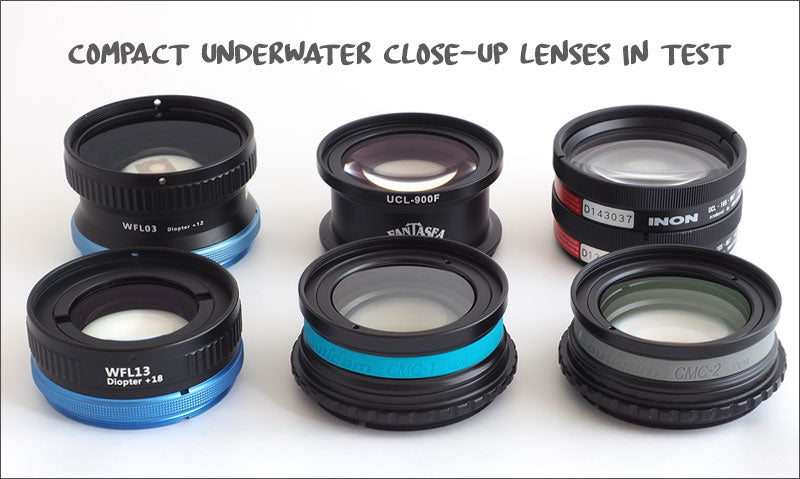Your Cart is Empty
- GoPro cameras are now available at MDC -
- GoPro cameras are now available at MDC -
camera packages
housings
Arms and trays
Accessories
High-magnification compact underwater close-up lenses in test
November 11, 2021 3 min read

There are confusingly many wet-interchangeable close-up conversion lenses available on the market today. Each claiming to be super sharp and having high magnification. These dioptre lenses have been evolving recently and are now smaller than ever and boasting very large magnification factors. To add to the confusion, some manufacturers use the dioptre number to classify their lenses, whereas manufacturers like Nauticam uses the magnification factor instead. It is generally very difficult to say exactly which lens does what. Also as these lenses are designed for underwater use, they behave slightly differently in water than on dry land. Hence, to test them properly, they will need to be submerged.
In this test, I have pitted against each other 5 popular compact underwater close-up diopter lenses including the new Weefine ultra-compact +18 lens that at least on paper promises a lot. I’ve also included the dual-stacked Inon UCL-165 M67 as a reference as these lenses are probably the most sold underwater conversion lenses in the world. The UCL-165 M67 is often the first uw close-up lens photographers obtain and although on its own, it is not that powerful (+6 dioptre according to the manufacturer) stacking these lenses together has been a popular way to capture even smaller critters without breaking the bank. It will be interesting to see how two Inon UCL-165 lenses will compare against the much more powerful adversaries.

imagine if you could actually use them like this :-)
The lenses in this test are:
1. Two Inon UCL-165 M67 (stacked)
2. Weefine WFL03 +12
3. Weefine WFL13 +18
4. Fantasea/AOI UCL-900F +15
5. Nauticam CMC-2
6. Nauticam CMC-1
All test pictures were taken in my test tank with a Sony RX100VA camera inside Fantasea FRX100 R housing. I’ve set the aperture to f5.6 and the images are taken from the closest possible focusing distance when the zoom of the camera is in the tele position (70mm)
Test pictures:





Results
The most powerful lens in this test is the ultra-compact Weefine WFL13 +18 lens with a 29mm wide target frame and 5cm minimum focusing distance. This lens should surely be a hit with underwater photographers as it is also the cheapest of the lot, currently retailing for £189.00. Worth remembering that this unit has quite small lens elements and can’t be used with large sensor cameras. The recommended maximum sensor size is 18mm x 13.5mm, which basically means m43rds. The second place is shared with the Nauticam CMC-1 (£318.00) and the Fantasea UCL-900F (£319.00) lenses, which both capture almost identical frame widths of 34 to 35mm (although CMC-1 is just fractionally weaker). The Fantasea however seems to have a slightly longer working distance.
The least amount of magnification with 48mm frame width with 9cm minimum focusing distance is produced by the Nauticam CMC-2 (£283.00) lens. The two stacked Inon lenses also provide ample magnification however the quilty seems to suffer as you can see some aberration in the edge areas of the frame. On paper, the stacked Inon UCL-165 should have a magnification of +12 but the Weefine WFL03 +12 lens manages to capture a slightly smaller area.
Here are the lenses in order by magnification in my test:
1. Weefine WFL13 +18 lens. Frame: 29mm, Distance: 5cm
2. Fantasea UCL-900F. Frame 34mm, Distance 6.5cm
3. Nauticam CMC-1 lens. Frame: 35mm, Distance: 5.5cm
4. Weefine WFL03 +12. Frame: 39mm, Distance: 6cm
5. Dual Inon UCL-165 M67. Frame: 42mm, Distance: 6cm
6. Nauticam CMC-2. Frame: 48mm, Distance: 9cm
(I would like to note that measuring the minimum focusing distance proved to be a quite difficult task, in my test tank, so these should be taken only as approximate figures)
See all underwater close-up lenses for sale at Mike's Dive Cameras
Subscribe
Sign up to get the latest on sales, new releases and more …
